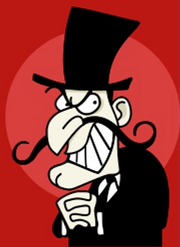m (Why are all these categories here? This page is not describing anyone.) |
(→Evolution Of Villainy: cleaning up writing style, grammar, etc. No change to meaning) |
||
| Line 7: | Line 7: | ||
===Evolution Of Villainy=== |
===Evolution Of Villainy=== |
||
| − | In the early days of |
+ | In the early days of media portrayal of villains (during the 18th, 19th, and 20th centuries) it was common for a villain to be portrayed as the archetypal "cackling madman" with little to no redeeming qualities. However, as audiences and society in general, matured villains became a less superficial in nature and the idea of villainy was evolved. It became popular for a villain to share similar qualities to a hero. This gave birth to the anti-hero and anti-villain as well as the tragic villain. In fact in modern times many writers are encouraged to steer away from outright villainous individuals and instead are inclined to create antagonists that are more three-dimensional so as to serve a wider audience. It is worth noting many villains in cartoons and children's media however retain the stereotypical villain. This is due to children's shows and cartoons being geared toward younger individuals who are unable to fully understand deeper, more philosophical concepts associated with anti-heroes and tragic villains. |
[[Category:About Villains]] |
[[Category:About Villains]] |
||
Revision as of 22:50, 28 May 2012
A villain is an "evil" character in a story, whether a historical narrative or, especially, a work of fiction. The villain is usually the bad guy or antagonist, the character who fights against the hero or protagonist. A female villain is sometimes called a villainess. Random House Unabridged Dictionary defines villain as "a cruelly malicious person who is involved in or devoted to wickedness or crime; scoundrel; or a character in a play, novel, or the like, who constitutes an important evil agency in the plot."
What makes a villain a villain is down to personal opinion on what "good" and "evil" is but there are a few acts that are universally accepted as villainous: betrayal, murder and deception as well as abuse (especially sexual abuse) - also it is an almost universal acceptance that harming a child is an "evil" act so any character who is deliberately cruel to a child more than once would be considered a villain. Also in most cultures it is considered extremely dishonorable (and often illegal) for a man to hit or other abuse a woman, of course this goes both ways but it is seen as especially immoral when committed by a male.
Also, many villains do not see themselves as "evil" - only appeaing as such to the 'good' guys - and may have just goals but go about their deeds in immoral, even wicked, ways - in fact the cackling maniac intent on destruction for the sake of destruction is a character-type that while still popular in fiction is beginning to fade away in favor of villains that display the same varied depths of emotions as heroes do: making them more three-dimensional characters than they were originally.

The stereotype of a "pure evil" villain is slowly beginning to fade in media geared for older audiences
Evolution Of Villainy
In the early days of media portrayal of villains (during the 18th, 19th, and 20th centuries) it was common for a villain to be portrayed as the archetypal "cackling madman" with little to no redeeming qualities. However, as audiences and society in general, matured villains became a less superficial in nature and the idea of villainy was evolved. It became popular for a villain to share similar qualities to a hero. This gave birth to the anti-hero and anti-villain as well as the tragic villain. In fact in modern times many writers are encouraged to steer away from outright villainous individuals and instead are inclined to create antagonists that are more three-dimensional so as to serve a wider audience. It is worth noting many villains in cartoons and children's media however retain the stereotypical villain. This is due to children's shows and cartoons being geared toward younger individuals who are unable to fully understand deeper, more philosophical concepts associated with anti-heroes and tragic villains.
